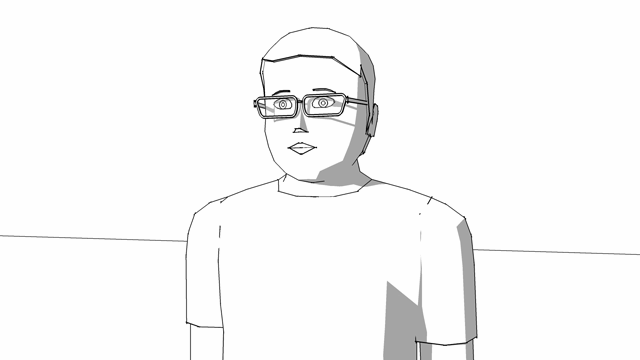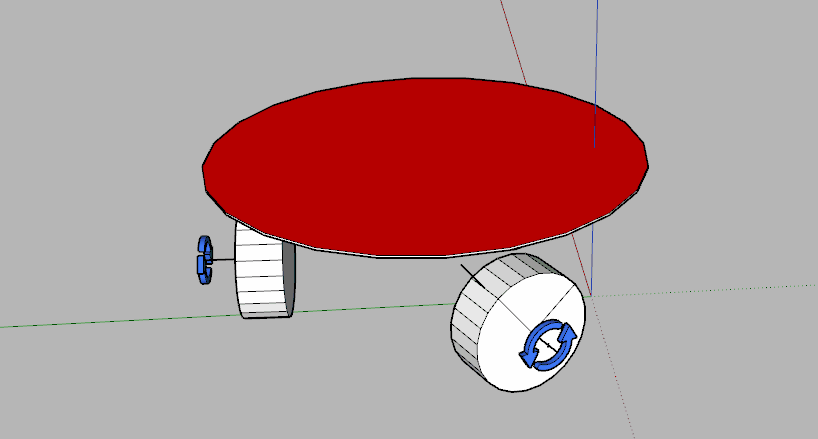MSPhysics 1.0.3 (16 October 2017)
-
Thanks for this help, that makes sense now. I knew there was something missing in the parents/children hierarchy but didn't know what. I may bother you with another question if you don't mind.
Can the plugin keep the starting point (considered to be 0 and with a defined value as maximum sliding lenght) of a slider joint applied to 3 sliding doors at the same level? Let's say I would launch the simulation and move them at different lenghts. In the end, I would stop the simulation and keep them at these various positions. But when launching the simulation again, it would consider the initial starting point as a limit for the three of them, no matter how far from it they are.
I don't know if i'm very clear, that's quite hard to explain but I can provide pictures if that does not make sense.
To simplify my question : Once simulation is stopped with objects moved, is it obliged that the reference point of the slider joint is changed according to each new position of the objects ?
I swear, that's my last one

-
@traxxx said:
To simplify my question : Once simulation is stopped with objects moved, is it obliged that the reference point of the slider joint is changed according to each new position of the objects ?
Yes, reference point is changed. In MSPhysics, stop simulation option is only when your aim is to have a final view; otherwise, use reset.
-
That's what I thought but I just wanted to be sure I wasn't missing anything ! Thanks !

-
Hello
My model is a bit complex and the frame rate becomes to low, I'm down to 6 frames/sec.
My graphic card is a AMD Radeon HD 7870, OS Win 10-64 bit, Processor Intel(R) Core(TM) i7-3770 CPU @ 3.40GHz, 3401 Mhz, 8 gig ram.What kind of hardware is recomended to speed things up?
I will appreciate your suggestions, thanks.
-
Hello Clue,
Your hardware is fine. It is MSPhysics plugin that needs succinct improvement and the model you configured for MSPhysics.
Anton
-
Can I use this plugin to simulate nails in wood? I can't figure out which joint to use.
-
Hi. Great thanks for an excellent tool


I have an issue with floathing items. I work as a professional with floating docks, and the MSP simulation in water is something I would really love to use; actually a perfect tool for me. But.. when making a pontoon with several materials, the simulation will give strange results. I believe there is a some kind of bug.
As attached is a simplified concrete pontoon of two parts: a shell of concrete and a float of styrofoam. When dropped to float, you see four different scenarios happen and none of them is accurate. From my point of view it would be easy if the simulation could work without calculation; just simply specifying the parts density, group them and let them float.
Thanks for your attention in advance!
-
@oheimala said:
I have an issue with floathing items. I work as a professional with floating docks, and the MSP simulation in water is something I would really love to use; actually a perfect tool for me. But.. when making a pontoon with several materials, the simulation will give strange results. I believe there is a some kind of bug.
As attached is a simplified concrete pontoon of two parts: a shell of concrete and a float of styrofoam. When dropped to float, you see four different scenarios happen and none of them is accurate. From my point of view it would be easy if the simulation could work without calculation; just simply specifying the parts density, group them and let them float.
The shell must consist from five separate subgroups, that is from four wall groups and one base/ceiling group. The top level group should be assigned Compound shape. That way, the collision shape generated will reflect the actual one. If you enable collision wireframe in simulation, you will see what is going on. So if you convexify subgroups, your resulting simulation would be realistic and the density you assign will reflect the density of material properly.
-
@ropefelt said:
Can I use this plugin to simulate nails in wood? I can't figure out which joint to use.
Yes you can, but the nails will not leave a hole in the wood. Just connect the nails to a piston joint and control them with a slider controller. Also, make sure the board or the nails are set to non-collidable.
-
Hi Anton,
A question for functions of a next version of MSPhysics:
Could it be possible to store transformations (translation, rotation, scaling) and manipulations off visibility on nested groups in the replay record data?
At present, these changes can be retained during an MSP session, played back and exported as a movie (frames), but disappear after saving, closing and reloading the replay data.
Here is an example of manipulating the visibility of embedded groups to achieve the effect of winking, if you want to test it.
Thanks!

-
@faust07 said:
Hi Anton,
A question for functions of a next version of MSPhysics:
Could it be possible to store transformations (translation, rotation, scaling) and manipulations off visibility on nested groups in the replay record data?
At present, these changes can be retained during an MSP session, played back and exported as a movie (frames), but disappear after saving, closing and reloading the replay data.
Here is an example of manipulating the visibility of embedded groups to achieve the effect of winking, if you want to test it.
Thanks!As far as I recall, you can already do that. In MSPhysics Replay Settings menu you can enable material record, style record, and other stuff. By default, only the camera and transformations are recorded.
Once you enable the recording, you will have to re-record, so that new data is recorded in your animation.
-
Oh, I don't think I've explained my problem clearly enough. I have to work on the translation. I meant the permanent storage of manipulations to subgroups in replay files. These are lost after closing the model file and later opening and loading the replay data.
-
Anton....firstly thanks for your AMAZING plugin. It is unbelievable how fast it is even on low powered hardware.
I have slider controls which I have added programmatically using ControlPanel.add_slider and ControlPanel.get_slider_value(name) and they work fine, but ControlPanel.set_slider_value(name, value) fails with an error in the html of the control panel which says something like error cannot find sliders.
Is there a fault in the html/javascript/missing file or am I doing something wrong?
AN EXAMPLE OF HOW TO SUCCESSFULLY SET A SLIDER VALUE WOULD HELP A LOTsincerely
Sujit Vasanth
PS. I can get round it by destroying all sliders and rebuilding them, but the redrawing slows my program down,
-
Hello,
I've used MSPhysics for a simulation on my project, and now, even after disabled the plugin, my model keeps with a "Created with MSPhysics 1.0.3" message on the upper left corner, and i can't manage to remove it.
Do you guys faced it?
Thanks in advance.
-
@lvskk said:
Hello,
I've used MSPhysics for a simulation on my project, and now, even after disabled the plugin, my model keeps with a "Created with MSPhysics 1.0.3" message on the upper left corner, and i can't manage to remove it.
There's a layer called MSPWatermarkText - just turn it off
-
Great extension. How to remove watermark with text: "Created with MSPhysics 1.0.3" If there is option to buy it where I can find it?
-
Hello,
I am trying to simulate an omnidirectional 3WD robot in MSphysics using motors and cylinders to simulate the omnidirectional wheel as shown in the attached file. However, the robot does not move in a straight line when the front wheels rotate at the speed but in opposite directions despiste being symmetric. Does anyone have any suggestions of what I can do please ? Thank you in advance.
-
The model is designed to move in this way. Which wheels are the front wheels?
Click on the image to animate.

-
I am trying to model the robot shown in this video,(https://www.youtube.com/watch?v=l__IKY-Xrw4&t=5s)
i.e the robot should be a able to move in the x and y plane without rotating by varying the speeds of each wheel independently. I have updated the model by replacing the cylinder wheel with two spheres, one of the sphere is attached to a motor while the other motor is allowed to rotate freely. However, the model still does not move in a straight line?Do you have any suggestions of what could be the problem please? Or is there any other way of how I can move a circular disc representing the robot platform that is able to move in any direction and rotate on its own axis in order to be able to bypass the mechanism of the omniwheels while retaining the stability provided by the three wheels?
I appreciate your help and thank you in advance.
-
@anton_s said:
@oheimala said:
I have an issue with floathing items. I work as a professional with floating docks, and the MSP simulation in water is something I would really love to use; actually a perfect tool for me. But.. when making a pontoon with several materials, the simulation will give strange results. I believe there is a some kind of bug.
As attached is a simplified concrete pontoon of two parts: a shell of concrete and a float of styrofoam. When dropped to float, you see four different scenarios happen and none of them is accurate. From my point of view it would be easy if the simulation could work without calculation; just simply specifying the parts density, group them and let them float.
The shell must consist from five separate subgroups, that is from four wall groups and one base/ceiling group. The top level group should be assigned Compound shape. That way, the collision shape generated will reflect the actual one. If you enable collision wireframe in simulation, you will see what is going on. So if you convexify subgroups, your resulting simulation would be realistic and the density you assign will reflect the density of material properly.
Hi Anton, thanks for your kind reply. So; complex pontoon structures may be tiny nightmares for floating simulations if the structures must be made from small simplified convex parts... Okay - I will test when I have resources for it, and I'll report. Fredo Tools "Convexify" may be the key

Advertisement







